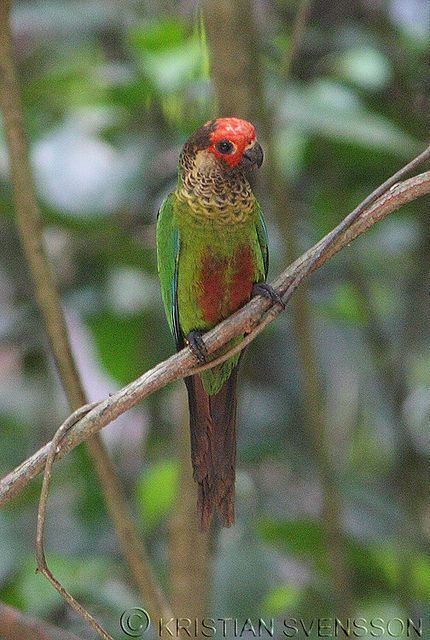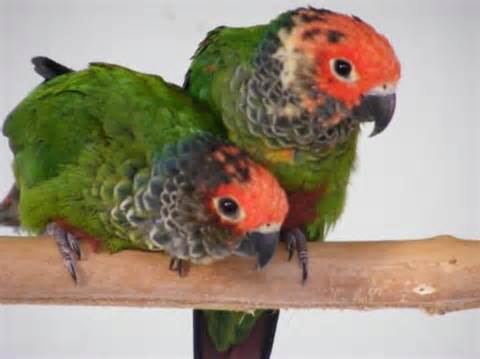Order Psittaciformes Rank Species | Phylum Chordata Superfamily Psittacoidea Subfamily Arinae Higher classification Pyrrhura | |
Similar Pyrrhura, Painted parakeet, Parrot, Bird, Bonaparte's parakeet | ||
The rose-fronted parakeet (Pyrrhura roseifrons), also known as the red-crowned parakeet (leading to easy confusion with the Cyanoramphus novaezelandiae), or, in aviculture, the rose-fronted conure, is a species of parrot in the family Psittacidae. It is found in the western Amazon basin in eastern Peru, far south-eastern Ecuador, north-western Bolivia and far western Brazil. It includes the wavy-breasted parakeet (P. roseifrons peruviana), also known as the wavy-breasted conure, which sometimes is considered a separate species (see Taxonomy).
Contents

Description
Total length ca. 22 cm (8 3⁄4 in). As other members of the Pyrrhura picta complex, it is a long-tailed mainly green parakeet with a dark red belly, rump and tail-tip (tail all dark red from below), a grey-scaled chest, a whitish or dull yellow patch on the auriculars and bluish remiges. The forehead, ocular region and carpal edge are red in the nominate race (P. r. roseifrons). Its bare eye-ring is typically dark greyish (sometimes indistinct) bordered by yellowish-white. The remaining subspecies, P. r. peruviana and P. r. dilutissima, lack any bright red in their plumage, but most of their crown and ocular region are very dark brownish-maroon (often appear blackish), while the forecrown is blue. Their eye-ring is grey. All races have dark grey legs.
Habitat and behavior

It occurs in tropical humid lowland forest and adjacent habitats. It is social and typically seen in pairs or groups. It feeds on fruits, seeds and flowers. The nest is placed in a tree cavity. It is fairly common in most of its range and occurs in several protected areas, e.g. Manú National Park.
Taxonomy

It has typically been considered a subspecies of the painted parakeet. While reviewing this group, Joseph (2002) discovered that an undescribed population existed in northern Peru (later also found in far south-eastern Ecuador). It was described as Pyrrhura peruviana (Hocking, Blake and Joseph, 2002). It was further recommended that P. roseifrons should be considered a monotypic species instead of a subspecies of P. picta. Ribas et al. (2006) confirmed by mtDNA that P. roseifrons should be considered a species separate from P. picta (otherwise P. picta would be paraphyletic), but also showed that peruviana was very close to, and therefore arguably better considered a subspecies of, P. roseifrons. Consequently, SACC voted to recognize P. roseifrons as a species with peruviana as a subspecies. Arndt (2008) recently described another taxon from this complex, dilutissima, as a subspecies of P. peruviana, but under the here used taxonomy, it becomes a subspecies of P. roseifrons.

The taxonomic status in relations to Bonaparte's parakeet and the so-called "group 6" (per Joseph, 2002) remains unclear. Arndt (2008) recently described the latter as a distinct species, P. parvifrons, but this has yet to receive widespread recognition (e.g. by SACC).

